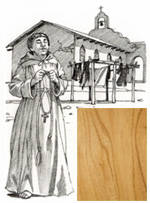Here is some very interesting information about the Chinaberry in American folklore. This must have been a more recent addition, as I didn’t find anything about it in my ~30yr collection of WOOD mags.
From WOOD Magazine.com:
http://www.woodmagazine.com/materials-guide/lumber/wood-species-1/chinaberry/
The answer to many a prayer

Seldom has a transplant been as happy as the chinaberry tree. Introduced to the sundrenched American Southwest and Mexico centuries ago for shade, the chinaberry embraced its arid new home and flourished. This cousin of mahogany from China relished the hot, dry climate and responded to it with rapid growth in even the worst of soil.
Native Americans, Mexicans, and new settlers in the barren land welcomed the new tree. Indeed, people cooled off beneath its branches, but didn’t hesitate to fell it for wood the worked into rustic furniture and tool handles, and burned for fuel. Still, the chinaberry offered them much, much more.
When denied the luxury of real soap or its ingredients, the resourceful sought out the generous chinaberry. By mashing its large, yellow, berrylike fruits and adding them to water, they whipped up a cleansing bath for grimy clothes. For this, chinaberry came to be called “soap tree.”
Should washday arouse an appetite, the chinaberry was there again. Although poisonous to humans, chinaberry fruits contain seeds that will catch fish, but in a most unlikely way. Crushed with a mortar and pestle, then thrown into a pool or pond, the seeds so stupify fish that they float to the top for easy catching with hands or net.
Could the beneficent chinaberry be the answer to a prayer? Maybe. For sure, it’s the stuff from which prayers are made! The same bone-hard, reddish-brown seeds that bowl over fish served the missionary friars of that part of the continent as rosary beads. With frequent use, the seeds took on a lustrous polish, as if responding to the spiritual purpose.
Photograph: Bob Calmer Illustration: Jim Stevenson
HorizontalMike









